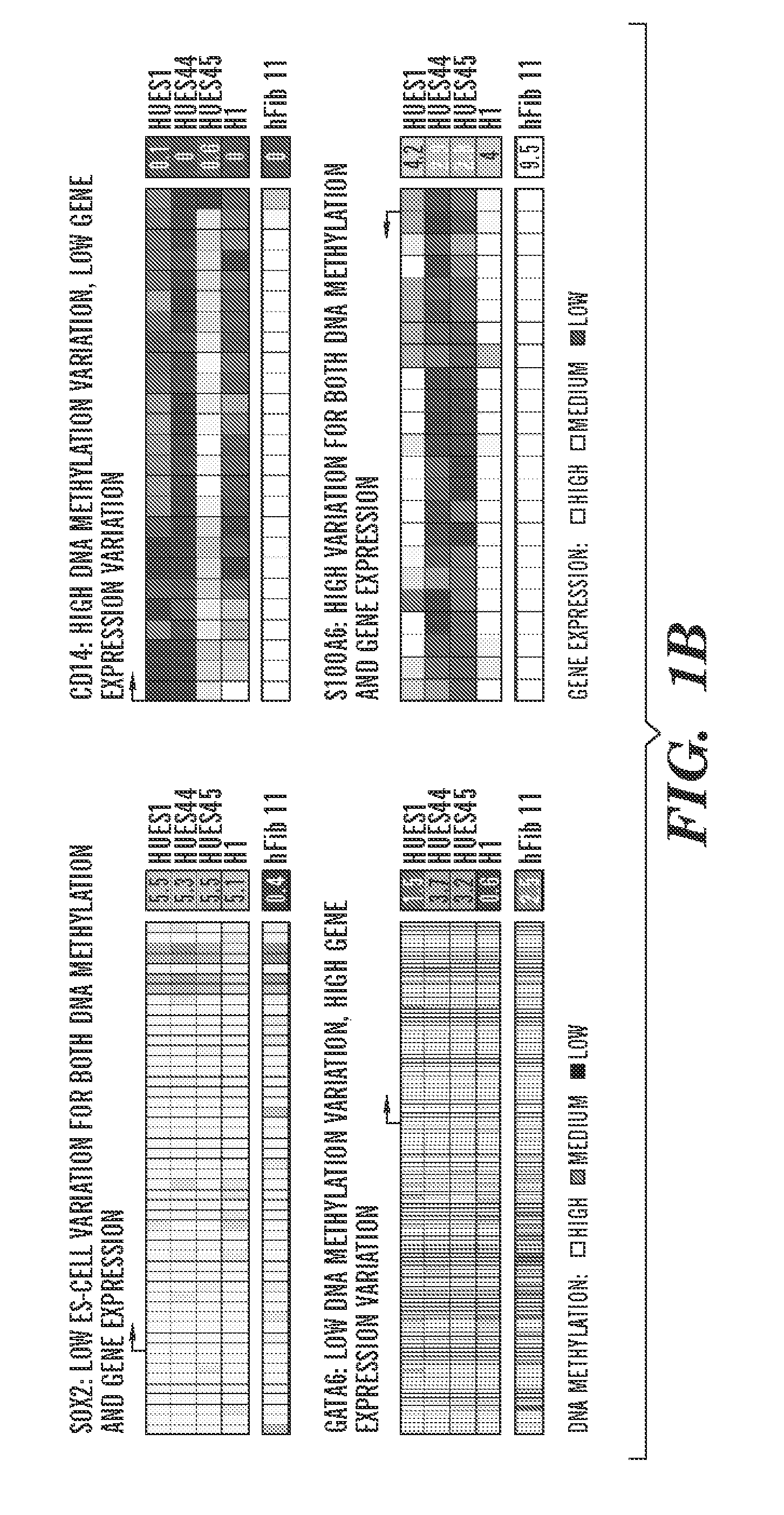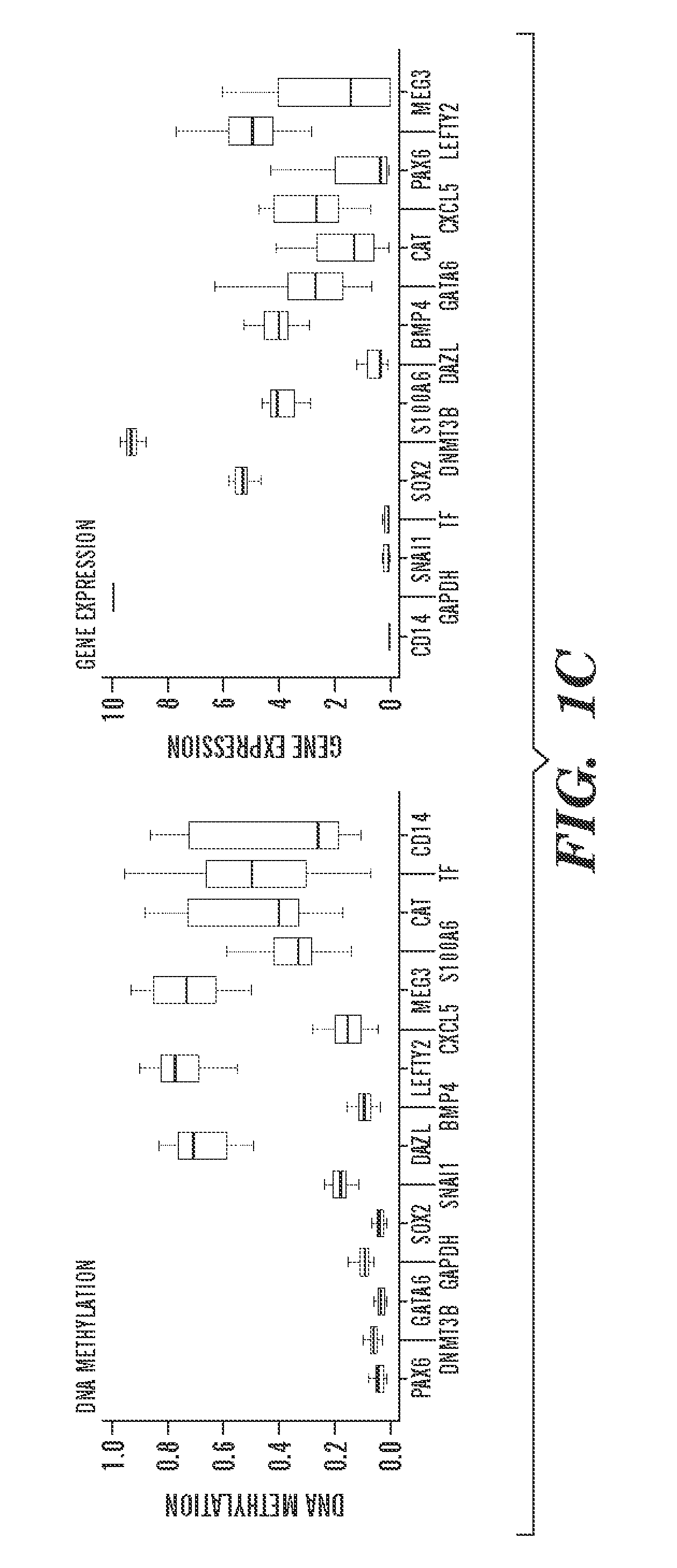Functional genomics assay for characterizing pluripotent stem cell utility and safety
a functional genomics and assay technology, applied in the field of methods for characterizing, can solve the problems of inability to predict the behavior of pluripotent stem cells in a given directed differentiation paradigm, and inability to identify suboptimal stems, etc., and achieve the effect of rapid and inexpensive characterization
- Summary
- Abstract
- Description
- Claims
- Application Information
AI Technical Summary
Benefits of technology
Problems solved by technology
Method used
Image
Examples
example 1
Variation in DNA Methylation and Transcription Between hES Cell Lines
[0926]There are many properties of a given ES cell line that could influence its DNA methylation, transcription or differentiation propensities. These could include the genetic background of a cell line, the way in which a line is cultured, selective pressure applied by extended in vitro growth, or unexplained stochastic noise. Before one can attempt to study the potential underlying causes of the variance in pluripotent stem cell line behavior, it is crucial to first determine both the nature and extent of variation that exists within a substantial cohort of lines.
[0927]To study inter-line variation between pluripontent stem cell populations or lines, the inventors obtained 19 human ES cell lines at low passage numbers (p15 to 25), cultured them for several passages under standardized conditions, then collected both DNA for analysis of DNA methylation and RNA for transcriptional profiling (Table 1, FIG. 8A). In or...
example 2
Causes and Consequences of Epigenetic and Transcriptional Variation Among Human ES Cell Lines
[0936]To begin to understand the causes and consequences of variation in transcription and methylation between the ES cell lines, the inventors used a “reference map” to quantify the level of variance in these measures for each locus (Tables 4 and 5). This quantification allowed the inventors to determine the proportion of genes that varied and the identity of genes with either minimal or substantial variance. The resulting distributions were highly skewed, with only 16% of all genes accounting for 50% of DNA methylation variation, and only 28% of all genes accounting for 50% of gene expression variation (FIG. 2A). Thus, most variation between cell lines is restricted to only a subset of loci and suggests that the identities of genes in these two classes might provide insight into why they vary and whether their variance would have any bearing on the properties of given lines.
[0937]The inven...
example 3
Global Patterns of DNA Methylation and Transcription are Similar Between hES Cells and hiPS Cells
[0942]The inventors “reference maps” of human ES cell line variation have enabled the inventors to determine the number and identity of genes that deviate from the norm in any new cell line through statistical comparisons with the ES-cell “reference corridor”. With the use of defined factor reprogramming to produce human iPS cell lines for various applications (Park et al., 2008b; Takahashi et al., 2007; Yu et al., 2007), there is an increasing need to determine how to select the most appropriate iPS cell lines for a given purpose. Mapping the variance in DNA methylation and transcription across iPS cell lines could allow one of ordinary skill in the art to determine whether there are loci that are systematically different between reprogrammed cells and their ES cell counterparts. This would furthermore help guide selection of high quality iPS cell lines similar to what is described here...
PUM
| Property | Measurement | Unit |
|---|---|---|
| size | aaaaa | aaaaa |
| molecular weight | aaaaa | aaaaa |
| molecular weight | aaaaa | aaaaa |
Abstract
Description
Claims
Application Information
 Login to View More
Login to View More - R&D
- Intellectual Property
- Life Sciences
- Materials
- Tech Scout
- Unparalleled Data Quality
- Higher Quality Content
- 60% Fewer Hallucinations
Browse by: Latest US Patents, China's latest patents, Technical Efficacy Thesaurus, Application Domain, Technology Topic, Popular Technical Reports.
© 2025 PatSnap. All rights reserved.Legal|Privacy policy|Modern Slavery Act Transparency Statement|Sitemap|About US| Contact US: help@patsnap.com



